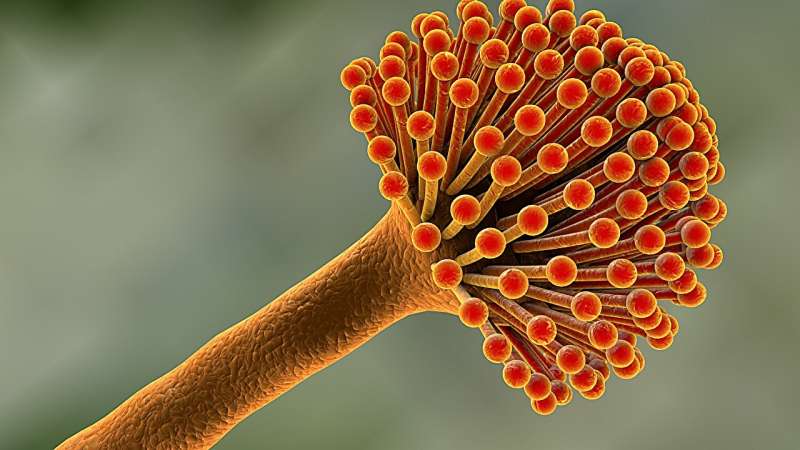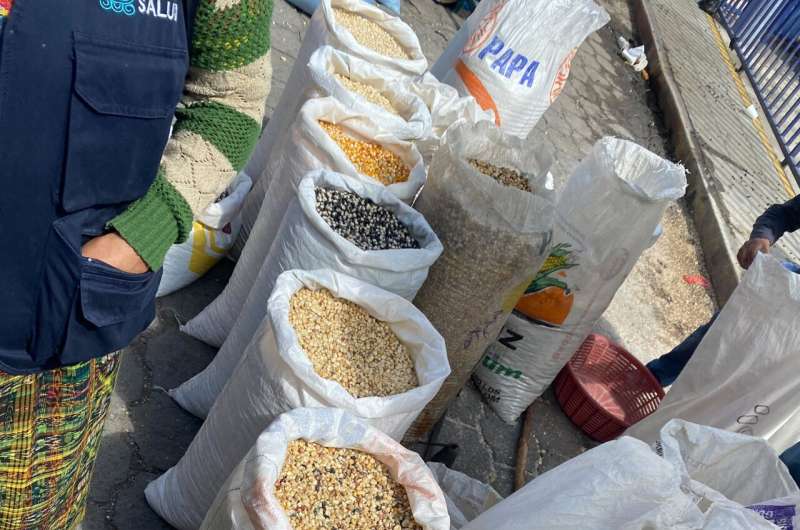This article has been reviewed according to Science X's editorial process and policies. Editors have highlighted the following attributes while ensuring the content's credibility:
fact-checked
trusted source
proofread
X-ray irradiation technique helps to control cancer-causing poison in corn

Corn, a staple food crop consumed by billions of people and animals worldwide, is frequently contaminated by the fungal toxin aflatoxin B1, a highly potent carcinogen produced by the fungus Aspergillus flavus.
Exposure to aflatoxin poses serious health risks to humans and other animals, and presents economic challenges to agricultural industries. However, due to the highly transmissible nature of the fungus coupled with the toxicity of the toxin, studying and developing control techniques in a laboratory setting can be difficult.
In a new study published in the journal Toxins, researchers at Arizona State University and their international colleagues have demonstrated a promising sterilization technique that uses X-ray irradiation to reduce Aspergillus flavus viability in contaminated corn. This method achieves sterilization without degrading the harmful aflatoxin B1 (AFB1) produced by the fungus.
By disabling Aspergillus flavus, the method stops the fungus from transmitting spores and producing more aflatoxins. This is crucial to allowing more laboratories to join the fight against fungal toxin prevention and control. Stabilizing toxin levels allows scientists to develop and test additional remediation techniques that target aflatoxin degradation without the complication of ongoing fungal growth. Results showed that a small dose of radiation shut down the fungal growth of Aspergillus flavus.
This work is part of a larger effort from Arizona State University researchers and international partners, to identify low-cost approaches to mitigate aflatoxin transmission and exposure among marginalized communities.
"We have known about aflatoxin since the 1960s, yet it is still a pervasive problem," says Hannah Glesener, lead author of the new study. "X-ray irradiating naturally contaminated corn is an exciting step that supports our research team's work on developing solutions for aflatoxin-related challenges, such as chronic malnutrition."
Glesener is a graduate research assistant in the Biodesign Center for Health Through Microbiomes and a biological design Ph.D. student in ASU's School for Engineering of Matter, Transport and Energy.
The team is now evaluating household-level cooking strategies for controlling this fungal toxin as well as the role of the human gut microbiome in potentially detoxifying foods prior to absorption into the bloodstream.

The global challenge of mycotoxin contamination
Aflatoxins are a type of mycotoxin, which are naturally occurring toxic compounds produced by molds or fungi that can grow on a variety of crops. Mycotoxins, including aflatoxins, have potent carcinogenic properties.
Aflatoxins are produced by Aspergillus species and are commonly found in crops including corn, cottonseed and nuts, particularly in warm and humid environments where mold thrives. Aflatoxin-producing fungi can contaminate crops at various stages, including in the field, during harvest and while in storage.
Aflatoxin contamination is a significant global concern, especially in humid, tropical and subtropical regions. It is most prevalent in Africa, Asia and parts of South America, where warm conditions can jump-start the growth of Aspergillus species.
An estimated 25% of the world's food crops are affected by mycotoxins, including aflatoxins, according to the Food and Agriculture Organization of the United Nations. Nigeria, Kenya, India and China are particularly affected due to their climate and agricultural practices.
Dangerous health effects of aflatoxin contamination
Acute aflatoxin poisoning, called aflatoxicosis, can occur when large quantities of contaminated food are consumed. Symptoms include liver damage, nausea, vomiting, abdominal pain and, in severe cases, death.
Aflatoxins are particularly associated with an increased risk of liver cancer. The International Agency for Research on Cancer classifies aflatoxins as Group 1 carcinogens, scientifically proven to cause cancer in humans. Chronic exposure can also lead to stunted growth in children and immunosuppression, increasing susceptibility to infectious diseases.
The World Health Organization estimates that aflatoxins contribute to approximately 5% to 28% of global cases of liver cancer, with the highest burden in sub-Saharan Africa, Southeast Asia and China. Every year, aflatoxin exposure is estimated to cause 25,000 to 155,000 liver cancer deaths worldwide. Further, the effects of aflatoxin exposure, even at lower levels, are more severe in animals.
Climate change is believed to exacerbate the threat posed by aflatoxins by expanding the geographic range of aflatoxin-producing fungi, potentially increasing contamination risks in new regions. Additionally, the economic burden caused by aflatoxin contamination is considerable, particularly in the developing world.
Study overview
The main objective of the study, led by corresponding author and Assistant Research Professor Lee Voth-Gaeddert, was to determine the optimal irradiation dose needed to eliminate fungal viability while preserving aflatoxin B1 concentrations for subsequent detoxification studies.
These results open new avenues for safely handling and researching contaminated food products without compromising the structural and chemical properties essential for scientific analysis. It can hopefully lead to new approaches for scalable and effective solutions to mycotoxin contamination applicable across various regions, particularly in developing countries where food safety measures are often limited.
More information: Hannah Glesener et al, X-ray Irradiation Reduces Live Aspergillus flavus Viability but Not Aflatoxin B1 in Naturally Contaminated Maize, Toxins (2024). DOI: 10.3390/toxins16080329
Provided by Arizona State University




















